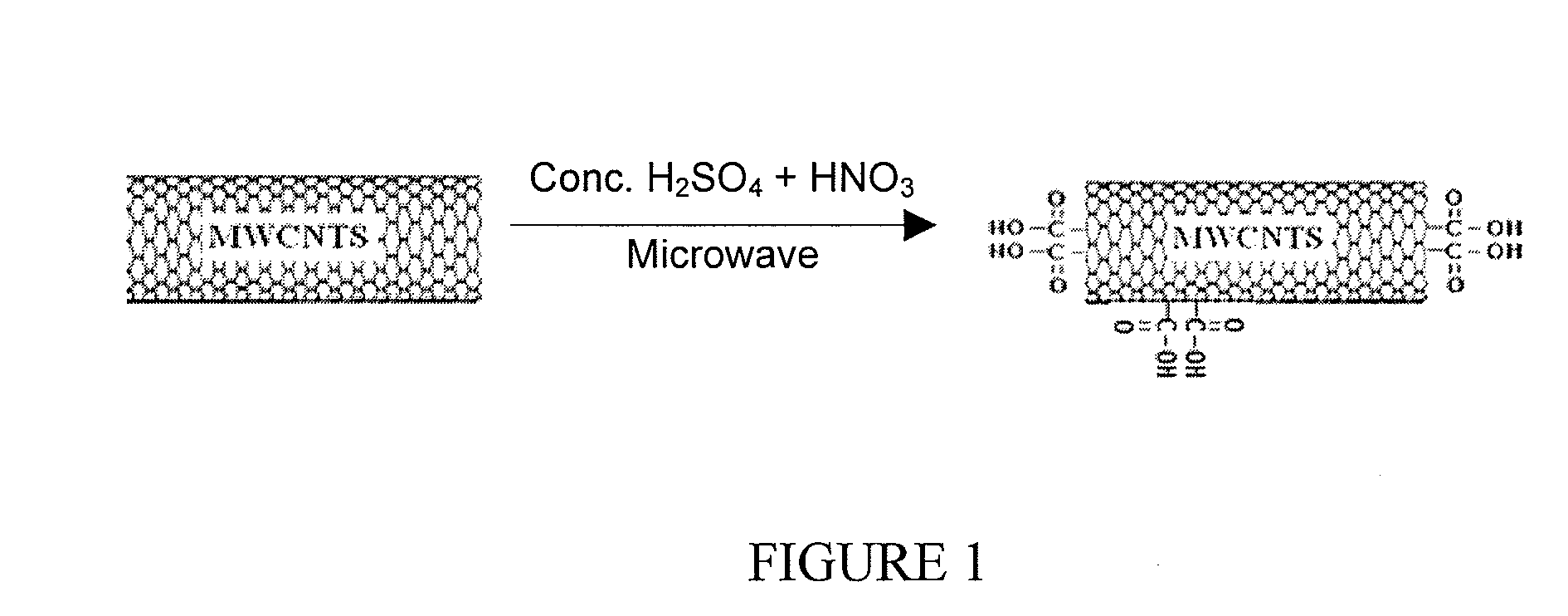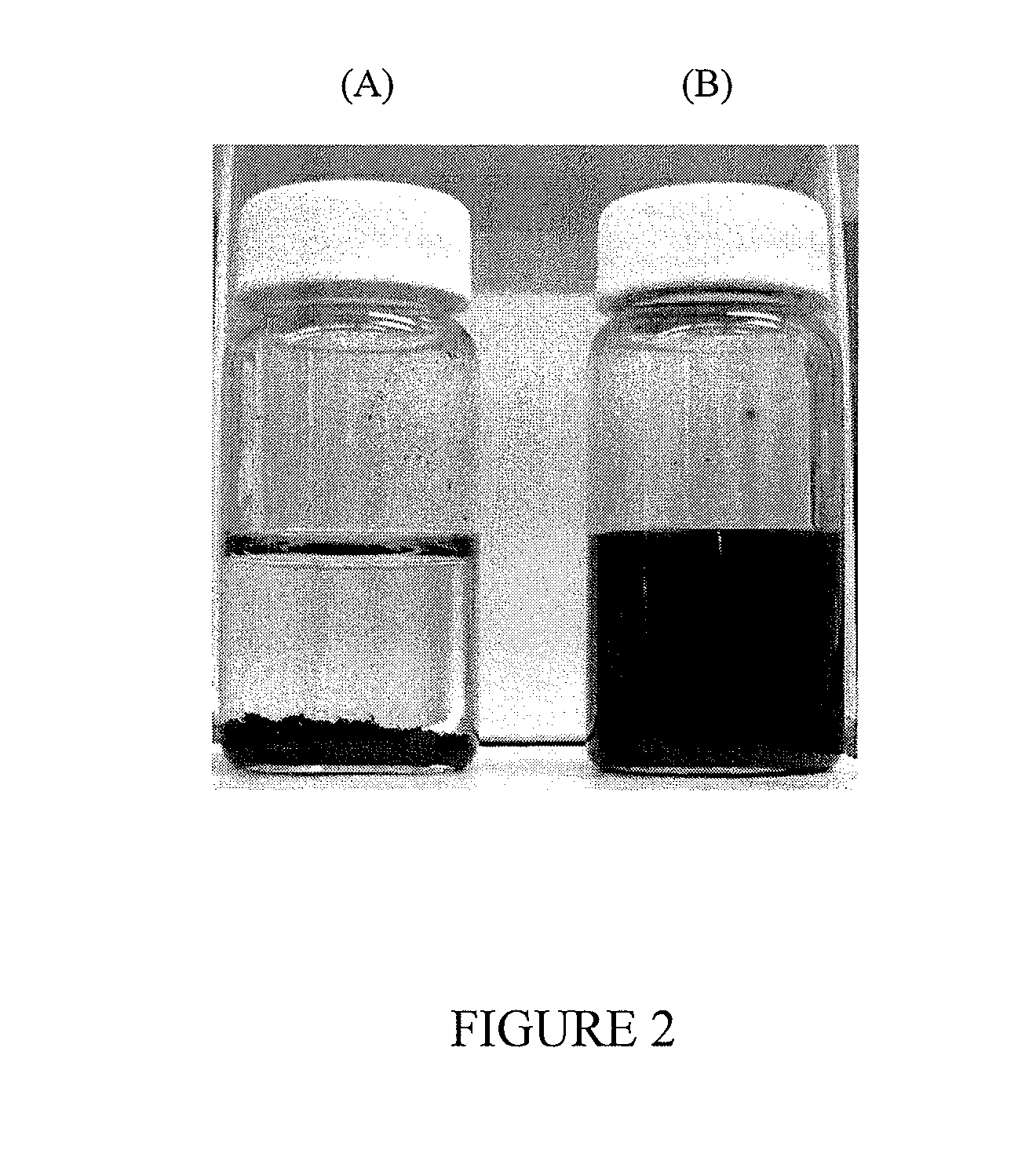Carbon Nanotube Mediated Membrane Extraction
a carbon nanotube and membrane technology, applied in solvent extraction, separation processes, transportation and packaging, etc., can solve the problems of difficult integrating cnts in the membrane and/or the membrane system, complex processes, and difficult separation of substantially pure polymeric membranes, etc., to improve the performance of the polymeric membrane or material.
- Summary
- Abstract
- Description
- Claims
- Application Information
AI Technical Summary
Benefits of technology
Problems solved by technology
Method used
Image
Examples
example 1
[0050]Dispersible CNTs were synthesized via covalent functionalization using an exemplary rapid microwave process (Refs. 30-31). For example, CNTs containing —COOH, —NO2 and —HSO3 were synthesized by treatment with 1:1 HNO3 / H2SO4 in a closed vessel microwave for approximately 20 minutes, at about 120° C. and at atmospheric pressure (Ref. 31). It is noted that CNTs containing any suitable organic or an inorganic group (e.g., —COOH, —NO2, amides, —HSO3, polymers and biomolecules) may be utilized in accordance with the present disclosure.
[0051]Further derivatization such as, for example, amidation is also possible in the microwave reactor (Ref. 30). Once the CNTs were functionalized, they were sonicated in water, acetone or ethanol for a few minutes to form a substantially uniform dispersion (Refs. 30-31). The derivatized CNTs have been characterized by microscopy and spectroscopy (Refs. 30-32). The presence of some of these functional groups also improves the adhesion to the membrane ...
example 2
[0053]Another approach to synthesize a NIM was as follows: the base porous membrane was polypropylene hollow fiber membrane (Accurel Q3 / 2 polypropylene hollow fiber) with an average pore size of about 0.2 μm, inner diameter or I.D. of about 600 μm, and outer diameter or O.D. of about 1000 μm. The CNTs were immobilized within the membrane using a dispersion of functionalized CNTs in a polymer solution. Alternatively, the CNTs may be immobilized within the membrane using a dispersion of functionalized CNTs in a monomer solution, or any other suitable solution (e.g., methyl methacrylate, polyvinyl pyrrolidone, polyurethane, polyamide, polyethylene and polyethylene glycol solutions). In an exemplary embodiment, the polymer selected was PVDF (polyvinylidene fluoride). This was accomplished by first dissolving about 0.1 mg of PVDF in 15 ml of acetone and dispersing about 10 mg of MWNTs in PVDF / acetone solution by sonicating for 3-4 hours. Alternatively, the dispersion of CNTs may take a v...
example 3
Synthesis and Characterization of Functionalized CNTs
[0057]Approximately 20 mg of CNT was placed in a Teflon lined microwave vessel and about 50 ml of a 1:1 (v / v) HNO3(aq):H2SO4(aq) mixture was added and the vessel sealed before being placed in a MARS microwave reactor (CEM, Matthews, N.C., USA) for 20 minutes microwave exposure with temperature set at 120° C. The reaction was as shown in FIG. 1, which depicts the reaction equation for acid functionalization of MWNTs.
[0058]The mixture was then cooled, removed and filtered, and the solid allowed to air dry. The functionalized CNTs were then dispersed in distilled water by sonication. FIG. 2 illustrates the insolubility of pure CNT compared to the dispersible nature of the functionalized CNTs. More particularly, FIG. 2 illustrates that: (A) pure CNTs were inert and precipitated out of water; and (B) functionalization facilitated the dispersion of the CNTs in water after adequate sonication. Alternatively, the dispersion of CNTs may ta...
PUM
| Property | Measurement | Unit |
|---|---|---|
| diameter | aaaaa | aaaaa |
| dispersion | aaaaa | aaaaa |
| metallic | aaaaa | aaaaa |
Abstract
Description
Claims
Application Information
 Login to View More
Login to View More - R&D
- Intellectual Property
- Life Sciences
- Materials
- Tech Scout
- Unparalleled Data Quality
- Higher Quality Content
- 60% Fewer Hallucinations
Browse by: Latest US Patents, China's latest patents, Technical Efficacy Thesaurus, Application Domain, Technology Topic, Popular Technical Reports.
© 2025 PatSnap. All rights reserved.Legal|Privacy policy|Modern Slavery Act Transparency Statement|Sitemap|About US| Contact US: help@patsnap.com



